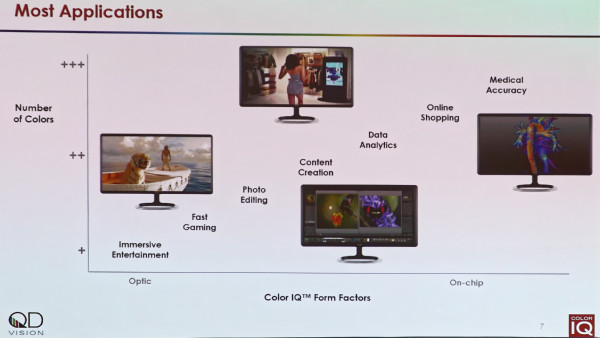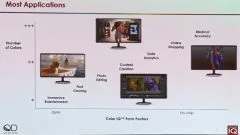This was the first year that this reporter was able to attend the annual Cowen Investor’s Conference as the bigger team allowed time to do it.
Steve Ward is CEO of QD Vision. He’s a heavy hitter and ex-CEO of Lenovo, having run the ThinkPad business at IBM. He started by looking back 25 years. There have been enormous changes in almost everything except the colour of the display. (I would add keyboards and mice as barely changed categories – Man. Ed.)
In the end, computing is almost always about the display. There’s no difference between a tablet and a TV, really, except the size of the display, said Ward. QDVision’s idea is to drive colour performance to the maximum number of people at affordable prices.
Colour is a factor of resolution and Ward said that accurate colour is a question of trust. People should be able to trust the colour on their display, but they don’t at the moment.
Quantum dots are appearing in real products and Ward said that TCL will show a “Rec 2020″ colour display on the show floor and there is a new 27” AOC monitor.
Getting colour to be accurate is about precise white points and skin tones. Tablets and phones have “virtual mirrors” and companies can add clothes to the images on these, which will encourage online fashion purchase, but at the moment, the colour is a long way from reality. Ward said that returns for “wrong colour” are at around 2% for retailers*. Colour is also a big opportunity in medical applications and Ward said that this could drive “huge economic value” across the industry.
To develop, you have to go where the growth is, which is to China. Where features cost 5% or less of the product, there is a real opportunity to persuade people to upgrade. There are around 1 million high end TVs and another 1 million monitor buyers that might spend that amount for better colour. At a 2% premium, the number goes up to 80 million TVs and with monitors also at 80 million. At 1%, you can effectively win the whole market, Ward said**.
At 1%, there is about a $1 billion opportunity (based on clients already signed, Ward said).

Konka will have a QD TV. Philips will add 55″ QD TVs in China. Hisense will show a 55″ QD TV at $1000 on the show floor later in the event, he said.
QDVision believes that direct electronics simulation of QDs is between three and seven years away and QDVision has most of its IP in that area.
In response to a question, Ward said that QDVision’s QDs are different from others by being able to be used nearer to the LED and are typically 0.6mm from the LED, which means that the volume of material is much smaller than what you need if you are much further away (e.g. film-based approaches). In the long term, you really want the QDs in the LED, as this minimises the quantity used, but sets big challenges of temperature stability.
In response to another question, Ward said that its QDs can be tuned very highly to generate the “full width half max” result.
Analyst Comment
*This argument about accurate colours for retailers has been going on a long time. The first initiative for this was, as far as I know, TIC or True Internet Color, an initiative run by Sonnetech, which made the Colorific software that better matched monitors to printers. Bill Hilliard of that company tried to get companies to adopt his technology. They found that the reality of online purchasing was that when consumers got the delivery, it didn’t matter if the colour was accurate. What mattered was whether they liked the colour as delivered. (BR)
** Ward conveniently forgot to mention at this point in his talk that his technology only goes into sets that are edge lit, which is, perhaps, 50% of the market, with an increasing trend to direct lit. (BR)

